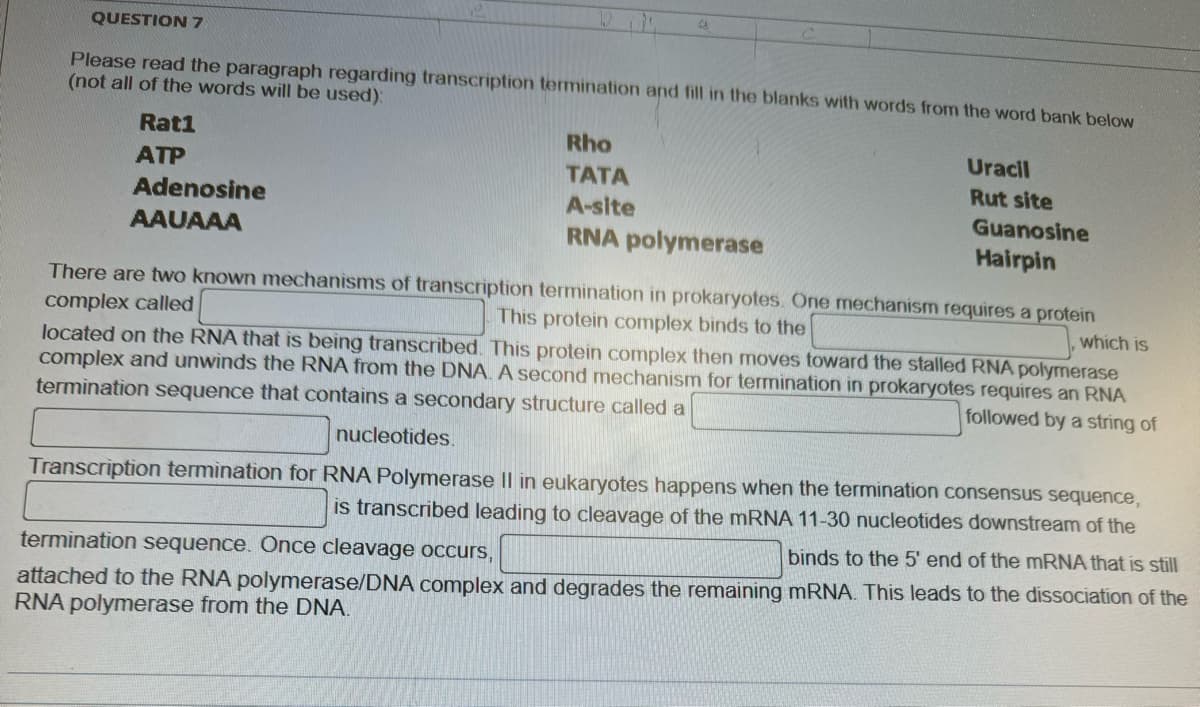a QUESTION 7 Please read the paragraph regarding transcription termination and fill in the blanks with words from the word bank below (not all of the words will be used): Rat1 ATP Adenosine AAUAAA Rho TATA A-site RNA polymerase Uracil Rut site Guanosine Hairpin There are two known mechanisms of transcription termination in prokaryotes. One mechanism requires a protein complex called This protein complex binds to the which is located on the RNA that is being transcribed. This protein complex then moves toward the stalled RNA polymerase complex and unwinds the RNA from the DNA. A second mechanism for termination in prokaryotes requires an RNA termination sequence that contains a secondary structure called a followed by a string of nucleotides. Transcription termination for RNA Polymerase II in eukaryotes happens when the termination consensus sequence, is transcribed leading to cleavage of the mRNA 11-30 nucleotides downstream of the termination sequence. Once cleavage occurs, binds to the 5' end of the mRNA that is still attached to the RNA polymerase/DNA complex and degrades the remaining mRNA. This leads to the dissociation of the RNA polymerase from the DNA.
a QUESTION 7 Please read the paragraph regarding transcription termination and fill in the blanks with words from the word bank below (not all of the words will be used): Rat1 ATP Adenosine AAUAAA Rho TATA A-site RNA polymerase Uracil Rut site Guanosine Hairpin There are two known mechanisms of transcription termination in prokaryotes. One mechanism requires a protein complex called This protein complex binds to the which is located on the RNA that is being transcribed. This protein complex then moves toward the stalled RNA polymerase complex and unwinds the RNA from the DNA. A second mechanism for termination in prokaryotes requires an RNA termination sequence that contains a secondary structure called a followed by a string of nucleotides. Transcription termination for RNA Polymerase II in eukaryotes happens when the termination consensus sequence, is transcribed leading to cleavage of the mRNA 11-30 nucleotides downstream of the termination sequence. Once cleavage occurs, binds to the 5' end of the mRNA that is still attached to the RNA polymerase/DNA complex and degrades the remaining mRNA. This leads to the dissociation of the RNA polymerase from the DNA.
Biochemistry
6th Edition
ISBN:9781305577206
Author:Reginald H. Garrett, Charles M. Grisham
Publisher:Reginald H. Garrett, Charles M. Grisham
Chapter29: Transcription And The Regulation Of Gene Expression
Section: Chapter Questions
Problem 1P
Related questions
Question

Transcribed Image Text:a
QUESTION 7
Please read the paragraph regarding transcription termination and fill in the blanks with words from the word bank below
(not all of the words will be used):
Rat1
ATP
Adenosine
AAUAAA
Rho
TATA
A-site
RNA polymerase
Uracil
Rut site
Guanosine
Hairpin
There are two known mechanisms of transcription termination in prokaryotes. One mechanism requires a protein
complex called
This protein complex binds to the
which is
located on the RNA that is being transcribed. This protein complex then moves toward the stalled RNA polymerase
complex and unwinds the RNA from the DNA. A second mechanism for termination in prokaryotes requires an RNA
termination sequence that contains a secondary structure called a
followed by a string of
nucleotides.
Transcription termination for RNA Polymerase II in eukaryotes happens when the termination consensus sequence,
is transcribed leading to cleavage of the mRNA 11-30 nucleotides downstream of the
termination sequence. Once cleavage occurs,
binds to the 5' end of the mRNA that is still
attached to the RNA polymerase/DNA complex and degrades the remaining mRNA. This leads to the dissociation of the
RNA polymerase from the DNA.
Expert Solution
This question has been solved!
Explore an expertly crafted, step-by-step solution for a thorough understanding of key concepts.
This is a popular solution!
Trending now
This is a popular solution!
Step by step
Solved in 2 steps

Recommended textbooks for you

Biochemistry
Biochemistry
ISBN:
9781305577206
Author:
Reginald H. Garrett, Charles M. Grisham
Publisher:
Cengage Learning

Biochemistry
Biochemistry
ISBN:
9781305577206
Author:
Reginald H. Garrett, Charles M. Grisham
Publisher:
Cengage Learning